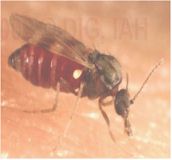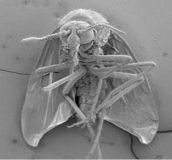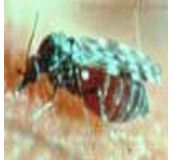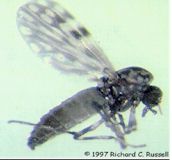| Common Name |
Biting Midges |
| Scientific Name |
Culicoides spp |
| Size |
45 mm long |
| Colour |
Grey |
| Description |
- The two wings possess dense hairs and give rise to pigmentation patterns.
- Large compound eyes are more or less contiguous above the bases of the 15-segmented antennae.
- The pedicel of the males' antennae houses the Johnston's organ. The
mouthparts are well-developed with cutting teeth on elongated mandibles
in the proboscis, adapted for blood-sucking in females, but not in
males.
- The thorax extends slightly over the head, and the abdomen is nine-segmented and tapered at the end.
|
| Habitat |
- Habitats such as mud, sand margins of rivers, lakes, ponds etc.
- They can also be found in decaying leaf mould and in tree hide
|
| Lifecycle |
- Eggs: females require blood for their eggs to mature. The number of eggs produced varies among species and size of blood meal.
- Larvae: Larvae require water, air and food and are not strictly aquatic or terrestrial. They cannot develop without moisture.
- Pupae: The pupal stage typically lasts ~ two to three days.
- Adults: Biting midges are holometabolous, progressing from egg to
larva to pupa, and finally to the adult stage. The complete cycle can
occur in two to six weeks, but is dependent on the species and
environmental conditions.
|
| Disease Transmitted |
Biting midges are the vectors of filarial worms in the genus
Mansonella. |
| Symptoms |
These parasites cause infection in humans that produces
dermatitis and skin lesions because the adult worms are located in the
skin. |
| Type of Damage |
An allergic dermatitis due to hypersensitivity to the
bites of Culicoides spp has been described under different names in
several parts of the world. |
| Sources / Breeding |
- Breeding areas can be very varied depending on the particular species.
- Areas with substantial salt marsh habitat are major producers of many biting midge species.
|
| Prevention |
- Homeowners can install proper screening for windows and patios to
prevent no-see-ums from entering residences and outdoor areas used for
leisure and entertaining.
- Most biting midges can pass through 16-mesh insect wire screen and
netting, so a smaller mesh size is required.
|
| Control |
- Removal trapping is conducted using CO2 as an attractant to lure the
biting midges to an insecticide-treated target where they are killed.
- Repellents containing DEET (N,N-diethyl-meta-toluamide) typically used
as mosquito repellents are also labelled for use against biting midges.
|







